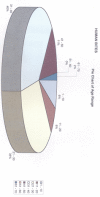HUMAN BITE INJURIES ON THE JOS PLATEAU
- PMID: 28344944
- PMCID: PMC5342835
HUMAN BITE INJURIES ON THE JOS PLATEAU
Abstract
Background: Human bite injuries with the associated morbidity are not uncommon in this environment.
Objective: To determine the pattern, management modalities and treatment outcome of human bites in Jos, Plateau State, Nigeria.
Design: A prospective study of all human bite injuries managed at the Jos University Teaching Hospital, Jos, Nigeria between January 2012 and December 2014.
Setting: Jos University Teaching Hospital, Jos, Nigeria.
Main outcome measures: The pattern and management outcome.
Results: A total of 63 patients with human bite injuries were studied during the three-year period. There were 43 males and 20 females with a male:female ratio of 2:1. The age ranged from 8 - 65 years with a mean age of 30.2+/-17 years; in all about 75% of the patients fell into the 20 - 40 years bracket. Though all the social strata were affected, the bites were more common (50%) among the lower social classes and 70% of the patients presented late after 24 hours of sustaining bite injuries. Pain, bleeding, infected wounds, bite and scratch marks were the main presenting features. About 70% of the patients sustained major bites involving the underlying muscles and deeper structures while 89% of the patients sustained their bites during a fight, 8% while raping their victims, and in 3% of patients as they were being mugged. The bites were between spouses in 39% of cases, and between women in polygamous settings in 16%. The sites commonly affected were the upper limbs in 46%, chest in 21%, ears in 13%, abdomen in 10% and the penis in 6%. The associated injuries were scratch marks in 89%, blunt abdominal injuries in 29%, skin lacerations in 16% and urinary bladder/urethral injuries in 3%. There was no mortality but morbidity was 57% which included infections in 29%, disfigurement in 29%, penile injuries in 6% and minor urethral injuries in 3% of cases.
Conclusion: Human bite injuries in this tropical environment commonly affected the young male, the lower social class and the upper limbs; they were commonly sustained in assaults and domestic conflicts.
Keywords: Assaults; Domestic conflicts; Human bites; Late presentation.; Low social class; Upper limbs; Young male adults.
Conflict of interest statement
Competing Interests: The authors have declared that no competing interests exist.
Figures
Similar articles
-
Abdominal injuries in communal crises: The Jos experience.J Emerg Trauma Shock. 2016 Jan-Mar;9(1):3-9. doi: 10.4103/0974-2700.173867. J Emerg Trauma Shock. 2016. PMID: 26957819 Free PMC article.
-
Experience in the management of the mass casualty from the January 2010 Jos Crisis.Niger J Clin Pract. 2016 May-Jun;19(3):364-7. doi: 10.4103/1119-3077.179276. Niger J Clin Pract. 2016. PMID: 27022801
-
Profile of dog bite victims in Jos Plateau State, Nigeria: a review of dog bite records (2006-2008).Pan Afr Med J. 2014 Jul 21;18 Suppl 1(Suppl 1):12. doi: 10.11694/pamj.supp.2014.18.1.4341. eCollection 2014. Pan Afr Med J. 2014. PMID: 25328631 Free PMC article.
-
A review of facial injuries due to dog bites.Med Oral Patol Oral Cir Bucal. 2006 Jul 1;11(4):E348-50. Med Oral Patol Oral Cir Bucal. 2006. PMID: 16816820 Review.
-
Above-elbow amputation and death following human bite mismanaged by quacks: a case report and review of literature.Niger J Med. 2012 Apr-Jun;21(2):249-51. Niger J Med. 2012. PMID: 23311202 Review.
Cited by
-
Editorial HUMAN BITE INJURIES.J West Afr Coll Surg. 2016 Apr-Jun;6(2):x-xi. J West Afr Coll Surg. 2016. PMID: 28344953 Free PMC article. No abstract available.
-
Surgical reconstruction of a W-shaped lower lip after extensive tissue loss and management of human bite wounds: A case report.Int J Surg Case Rep. 2025 Aug;133:111512. doi: 10.1016/j.ijscr.2025.111512. Epub 2025 Jun 14. Int J Surg Case Rep. 2025. PMID: 40527005 Free PMC article.
-
PENILE INVAGINATION COMPLICATED BY HERNIA THROUGH THE SCROTUM - CASE REPORT.J West Afr Coll Surg. 2018 Jan-Mar;8(1):110-115. J West Afr Coll Surg. 2018. PMID: 31754618 Free PMC article.
References
-
- Douglas LG. Bite wounds. American Family Physician. 1975;11:93–99. - PubMed
-
- Liston PN, Tong DC, Firth NA, Kieser JA. Bite injuries: pathophysiology, forensic analysis and management. N Z Dent J. 2001;97:58–63. - PubMed
-
- Griego RD, Rosen T, Orengo IF, Wolf JE. Dog, cat, and human bites: a review. J Am Acad Deamatol. 1995;33:1019–1029. - PubMed
-
- Brook I. Microbiology and management of human and animal bite wound infections. Prim Care. 2003;30:25–39. - PubMed
-
- Kennedy SA, Stoll LE, Lauder AS. Human and other mammalian bite injuries of the hand: evaluation and management. J Am Acad Orthop Surg. 2015;23:47–57. - PubMed
LinkOut - more resources
Full Text Sources



